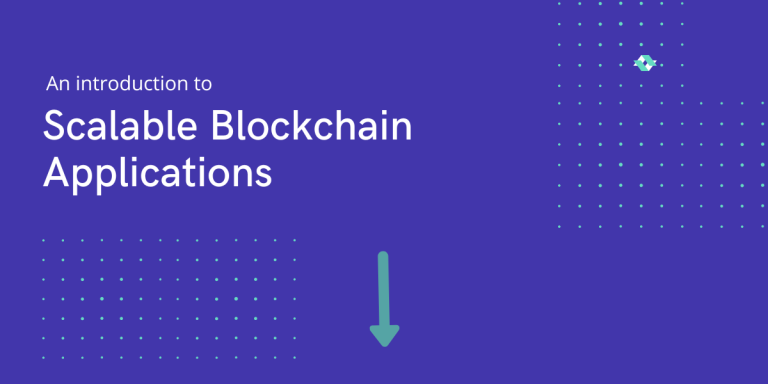The scalability of a blockchain is the maximum number of transactions that can be processed per second. Bitcoin, for example, can handle around seven transactions per second. Ethereum can handle around 15. Compare this to Visa, which can handle 24,000 transactions per second.
In this article, let’s understand scalability further and understand the benefits and challenges of creating scalable blockchain applications.
What Are Scalable Blockchain Applications?
Scalable blockchain applications are those that can handle a large number of transactions per second. Bitcoin, for example, can handle around seven transactions per second. Ethereum can handle around 15. Compare this to Visa, which can handle 24,000 transactions per second.
There are a few different ways to make a blockchain more scalable. One is to make the blocks smaller so that more can fit into each block. Another is to increase the number of transaction confirmations that are required before a transaction is considered valid.
One of the most promising scalability solutions is the Lightning Network. The Lightning Network is a second-layer solution that uses smart contracts to create a network of channels between participants. These channels can be used to process an unlimited number of transactions without the need to record them on the blockchain.
The Lightning Network is still in development and is not yet available on all blockchain networks. However, it has the potential to greatly increase the scalability of blockchain applications and make them more viable for large-scale use cases.
How Do Scalable Blockchain Applications Work?
Scalability is a major challenge for blockchain applications. The problem is that as the number of users and transactions on a blockchain network increases, the network becomes slower and more expensive. This is due to the fact that each node on a blockchain network must validate every transaction, and this takes time and resources.
There are several ways to improve the scalability of blockchain applications.
- One way is to increase the block size, which allows more transactions to be processed per block.
- Another way is to use sharding, which splits the blockchain into multiple shards that can be processed in parallel.
- Finally, there are a number of off-chain solutions that allow transactions to be processed outside of the blockchain, which can be much faster and cheaper.
One of the most promising scalability solutions is the Lightning Network. The Lightning Network is a second-layer payment protocol that runs on top of a blockchain. It uses smart contracts to create a network of channels between participants.
These channels allow for near-instant and cheap transactions, without the need to validate each transaction on the blockchain. The Lightning Network is still in development, but it has the potential to greatly improve the scalability of blockchain applications.
Benefits of Scalable Blockchain Applications
The blockchain is a distributed database that allows for secure, transparent and tamper-proof record-keeping. This makes it an ideal platform for developing scalable applications. Scalable blockchain applications have several benefits. Here are 7 major benefits of using a scalable blockchain application:
Increased Efficiency
The decentralised nature of the blockchain means that there is no need for a central authority to manage and verify transactions. This results in increased efficiency and reduced transaction costs.
Reduced Costs
Scalable blockchain applications can help businesses reduce costs. When businesses use a scalable blockchain application, they can process more transactions per second.
Improved Security
The use of cryptographic techniques ensures that data on the blockchain is secure and cannot be tampered with. This makes it an ideal platform for developing applications that require high levels of security.
Increased Transparency
All transactions on the blockchain are publicly visible, making it easy to track down any potential fraud or misuse of funds. This also helps to improve transparency and accountability within organisations that use the blockchain.
Improved Traceability
Scalable blockchain applications can help businesses improve traceability. When businesses use a scalable blockchain application, they can process more transactions per second. This increased efficiency can help businesses reduce the chances of fraudulent activities and improve traceability.
Increased Accountability
The immutable nature of the blockchain means that all data is permanently stored and can be easily traced back to its source. This makes it an ideal platform for tracking assets or product origins.
Challenges of Creating Scalable Blockchains
Creating scalable blockchain applications is difficult for a number of reasons. Here are some of the challenges:
- Blockchains are designed to be immutable, meaning that once data is written to the blockchain it cannot be changed. This makes it difficult to make changes to the blockchain, which can be a problem when trying to scale an application.
- Blockchains are also designed to be distributed, meaning that they are spread across many different computers (nodes). This can make it difficult to make changes to the blockchain, as all nodes would need to be updated.
- The consensus mechanism used by most blockchains (Proof of Work) is also very resource intensive, meaning that it can be difficult to scale a blockchain application.
- Finally, the use of smart contracts can also make it difficult to scale a blockchain application, as each smart contract needs to be executed on all nodes in the network.
Conclusion
From the above, it is evident that blockchain technology is still in its nascent stages with a lot of room for improvement in terms of scalability. However, the fact that it is a secure, decentralized and tamper-proof ledger makes it a promising technology with a lot of potential applications.





